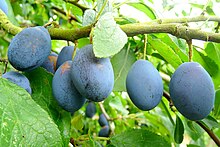
Back Prunus domestica subsp. insititia AN دمسون Arabic Prunus insititia Azerbaijani Kriachal BAR Prunyoner Catalan Slivoň slíva Czech Kræge Danish Kriechen-Pflaume German Psowica DSB Prunus domestica subsp. insititia Spanish
| Damson | |
|---|---|

| |
| Ripe damsons | |
| Scientific classification | |
| Kingdom: | Plantae |
| Clade: | Tracheophytes |
| Clade: | Angiosperms |
| Clade: | Eudicots |
| Clade: | Rosids |
| Order: | Rosales |
| Family: | Rosaceae |
| Genus: | Prunus |
| Section: | Prunus sect. Prunus |
| Species: | |
| Subspecies: | P. d. subsp. insititia
|
| Trinomial name | |
| Prunus domestica subsp. insititia | |
The damson (/ˈdæmzən/) or damson plum (Prunus domestica subsp. insititia, or sometimes Prunus insititia),[1] also archaically called the "damascene",[2] is an edible drupaceous fruit, a subspecies of the plum tree. Varieties of insititia are found across Europe, but the name damson is derived from and most commonly applied to forms that are native to Great Britain.[3] Damsons are relatively small ovoid plum-like fruit with a distinctive, somewhat astringent taste, and are widely used for culinary purposes, particularly in fruit preserves and jams.
In South and Southeast Asia, the term damson plum sometimes refers to jamblang, the fruit from a tree in the family Myrtaceae.[4] The name "mountain damson" or "bitter damson" was also formerly applied in Jamaica to the tree Simarouba amara.[5]
- ^ M. H. Porcher "Sorting Prunus names", in "Multilingual multiscript plant names database, University of Melbourne. Plantnames.unimelb.edu.au. Retrieved on 2012-01-01.
- ^ Samuel Johnson equates "damascene" and "damson" and for "damask plum" simply states "see Plum" (A Dictionary of the English Language, 1755, p. 532). Later expanded editions also distinguish between "damascene" and "damson", the latter being described as "smaller and [with] a peculiar bitter or roughness".
- ^ Woldring (1998), p. 538
- ^ "Jambolan". Purdue University. 2006.
- ^ Bowerbank, "The Commercial Quassia, or Bitterwood", The Technologist, II (1862), 251
© MMXXIII Rich X Search. We shall prevail. All rights reserved. Rich X Search